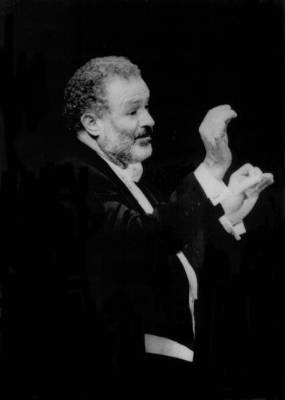|
<< -- 3 -- Maria Nockin A STRAIGHT LINE CAREER PATH

MN: Do you have to adjust your tempi for different voices?
KM: When I did The Barber of Seville in Santa Fe I had two different Rosinas, Kirstin Chavez and Ana Maria Martinez. They have very different voices. Chavez has a deeper voice so you have to go more slowly with her. With the higher voiced Martinez we went quite a lot faster. It's always necessary to fit your tempi to the singers and it's what composers of Rossini's time expected. It's quite easy to adapt once you've gotten used to the voice. There are only a few composers I won't touch, but one of them is Puccini. I don't really understand him. I've done some of his operas but I don't think I do them as well as other people so I leave them alone. Their stories don't resonate very well with me. It's not the music, it's the stories.
MN: What are you doing in Santa Fe this summer?
KM: It will be Massenet's Cendrillon with some wonderful singers: Joyce di Donato, Kristine Jepson, Judith Forst and Richard Stillwell. The director is Laurant Pelly with whom I worked on La belle Hélène there. I loved working with him. He is a man of tremendous imagination with a very light, but cutting, touch. His parents sang in a traveling Offenbach Company and he was brought up on lighter opera. He is also a very distinguished director of straight theater. He has his own company, The Cargo-Centre Dramatique National des Alpes, in the French city of Grenoble. I think he will bring a very interesting touch to Cendrillon which is a lovely opera, beautiful for the orchestra with a touch of fantasy about it. Massenet is an underrated composer in my opinion. I find him to be a great craftsman.

Kenneth Montgomery. Photo © La Scala, Milan
|
MN: How much instrumental music do you perform?
KM: I try to do half vocal and half instrumental. Of course, it varies from year to year. Some years I do three or four operas, but three is really the maximum number of operas I want to do in a year. The rest of the time I do symphonic work. The problem with opera is that it's very difficult to put it all together. It can become a little bit routine and it can be difficult to get what you want. On the other hand, with opera you spend four, six or even eight weeks in one place and that's good. You spend the maximum of a week with a symphony orchestra. I find that opera and symphony nourish each other musically speaking. As a result of working in both fields, one has the dramatic impact of the opera to bring to the symphony and the more intellectual and architectural approach of the symphony to bring to opera.
Continue >>
Copyright © 22 January 2006
Maria Nockin, Arizona USA

| 
